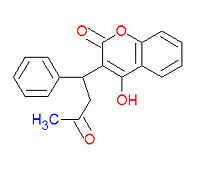CZ:Featured article/Current: Difference between revisions
imported>Chunbum Park No edit summary |
imported>Anton Sweeney m (typo) |
||
| Line 5: | Line 5: | ||
'''[[Warfarin]]''' (IUPAC name | '''[[Warfarin]]''' (IUPAC name | ||
4-hydroxy-3-(3-oxo-1-phenylbutyl)-2H-chromen-2-one), also widely called coumadin, is | 4-hydroxy-3-(3-oxo-1-phenylbutyl)-2H-chromen-2-one), also widely called coumadin, is an anticoagulant medication used prophylactically to suppress the formation of embolism and thrombosis from conditions such as atrial fibrillation, deep venous thrombosis, and pulmonary embolism. | ||
Originally designed to be a rat poison, warfarin works as an anticoagulant by suppressing the enzyme epoxide reductase in the liver, thereby suppressing the formation of the reduced form of vitamin K epoxide, which is needed for the synthesis of many coagulation factors. As a drug, it is often sold as the sodium salt of warfarin. | Originally designed to be a rat poison, warfarin works as an anticoagulant by suppressing the enzyme epoxide reductase in the liver, thereby suppressing the formation of the reduced form of vitamin K epoxide, which is needed for the synthesis of many coagulation factors. As a drug, it is often sold as the sodium salt of warfarin. | ||
Revision as of 04:31, 5 December 2011
Warfarin
by Robert Badgett, David E. Volk, and Chris Day (and Caesar Schinas)
Warfarin (IUPAC name 4-hydroxy-3-(3-oxo-1-phenylbutyl)-2H-chromen-2-one), also widely called coumadin, is an anticoagulant medication used prophylactically to suppress the formation of embolism and thrombosis from conditions such as atrial fibrillation, deep venous thrombosis, and pulmonary embolism.
Originally designed to be a rat poison, warfarin works as an anticoagulant by suppressing the enzyme epoxide reductase in the liver, thereby suppressing the formation of the reduced form of vitamin K epoxide, which is needed for the synthesis of many coagulation factors. As a drug, it is often sold as the sodium salt of warfarin.
Discovery
The dangers of feeding livestock spoiled sweet clover hay were known in the 1920’s[1] and scientists at the University of Wisconsin-Madison were spearheading the problem on multiple fronts. R.A. Brink and W.K. Smith were attempting to breed a new variety of clover that was free of the toxic effect and Karl Paul Link's laboratory was attempting to isolate the killer compound. Farmers were already hurting due to the Great Depression and despite knowing they should not feed their livestock such hay, they could not afford to buy uncontaminated supplies. This disease that was affecting many livestock throughout the US became known as "sweet clover disease".[2]
| notes |
|---|
|
